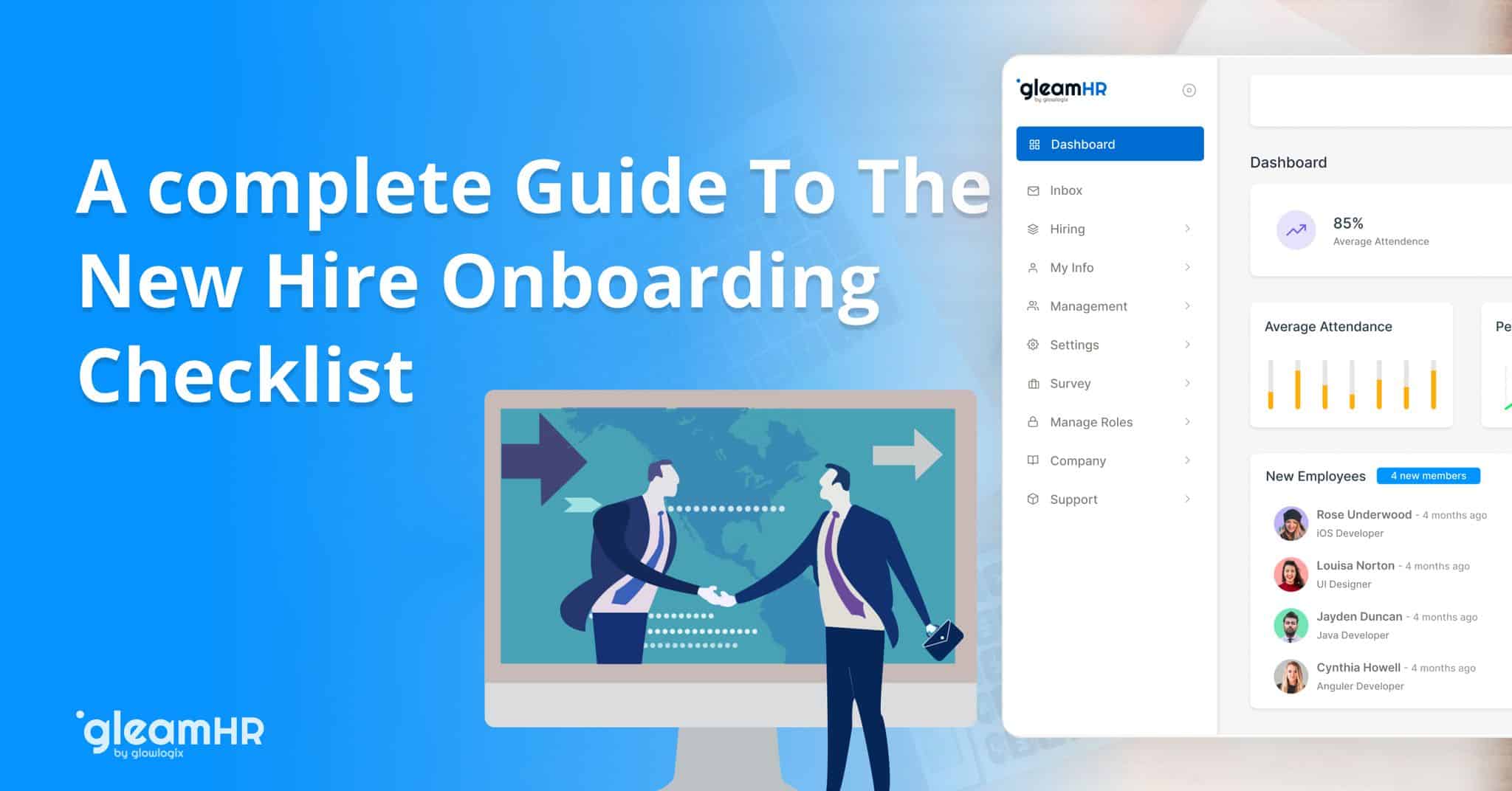Hiring new talent is an exciting milestone for any organization. It marks growth, opportunity, and the promise of fresh perspectives. However, the process of bringing a new employee into the fold involves more than just a job offer. It’s a multifaceted journey that begins with recruitment and selection and extends into the critical phase of new hire onboarding.
In this comprehensive guide by GleamHR, we’ll explore the best ways to recruit employees, from sourcing candidates to welcoming them aboard with a well-structured onboarding plan. We’ll also touch on the role of recruitment automation software, the importance of a user-friendly hiring website, and the seven essential steps in the recruitment process.
The Hiring Process: A Holistic View:
Before diving into the specifics of new hire onboarding, it’s essential to understand that the journey begins long before the candidate walks through your office doors or logs into your virtual workspace. The hiring process can be broken down into several key stages, each crucial in its own right:
Sourcing Candidates:
The first step in hiring is finding the right candidates for your job openings. This can involve posting job listings on your company website, utilizing job boards, partnering with recruitment agencies, and tapping into professional networks like LinkedIn. The goal here is to cast a wide net to attract a diverse pool of qualified candidates.
Recruitment and Selection Process:
Once you’ve gathered a pool of applicants, the recruitment and selection process begins. This typically involves reviewing resumes, conducting interviews, and assessing candidates through various means, such as skills tests, personality assessments, and reference checks. The aim is to identify the candidates who best fit the job requirements and align with your company culture.
Interview Process:
Interviews are a crucial aspect of the recruitment and selection process. They provide an opportunity to evaluate a candidate’s skills, experience, and cultural fit. Interviews can be conducted in person, over the phone, or through video conferencing. Effective interviewing techniques include asking behavioral questions, assessing problem-solving skills, and gauging a candidate’s enthusiasm for the role.
Job Offer:
Once you’ve identified the ideal candidate, it’s time to extend a job offer. This includes detailing the terms of employment, such as salary, benefits, and start date. Make sure the offer is clear and that you provide ample time for the candidate to consider and accept.
Background Checks and References:
Before finalizing the hire, conduct background checks and contact references to verify the candidate’s qualifications and character. This step helps ensure that you’re making a well-informed decision.
Onboarding Process:
With the candidate accepting the job offer, the next phase is the onboarding process. This is where the new hire transitions from being a candidate to becoming a full-fledged member of your organization.
New Hire Onboarding:
New hire onboarding is the focus of this guide, and it’s a critical step in the hiring process. This phase is often underestimated but plays a vital role in setting the tone for an employee’s entire tenure with your company. Effective onboarding can lead to higher job satisfaction, faster integration into the team, and increased productivity.
The Importance of New Hire Onboarding:
Imagine you’ve just hired a talented individual who aced the interview process. They have the skills, the experience, and the enthusiasm you were looking for. However, without a structured onboarding process, their journey into your company may start on a shaky foundation.
Effective new hire onboarding is essential for several reasons:
- Accelerated Integration: A well-structured onboarding program helps new hires become productive team members more quickly.
- Cultural Alignment: It introduces them to your company’s values, mission, and culture, aiding in their alignment with your organization’s goals.
- Reduced Turnover: Proper onboarding can lead to higher job satisfaction, which in turn reduces employee turnover rates.
- Compliance and Training: Onboarding ensures that new hires are aware of company policies, procedures, and any necessary training.
- Improved Morale: A positive onboarding experience can boost employee morale and engagement.
Building an Effective Onboarding Checklist:
Creating a comprehensive onboarding checklist is the cornerstone of successful new hire integration. Here are the key elements to include in your onboarding plan:
Welcome and Orientation:
Begin with a warm welcome message from the company’s leadership. Provide a detailed orientation session that covers the organization’s history, mission, vision, and values.
Paperwork and Compliance:
Ensure all necessary paperwork is completed, including tax forms, employment agreements, and company policies. Make it easy for new hires to access and submit these documents digitally.
Company Culture and Values:
Educate new hires about your company culture and values. Share stories that exemplify your culture and introduce them to their future colleagues.
Training and Development:
Offer training sessions to help new hires get up to speed quickly. This could include technical training, product knowledge, or soft skills development.
Introduction to Tools and Technology:
Familiarize new employees with the tools and technologies they’ll be using daily. Ensure they have the necessary access and permissions.
Mentorship and Buddy System:
Assign mentors or buddies to help new hires navigate their first few weeks on the job. Having someone to turn to for questions or guidance can be invaluable.
Departmental Overviews:
Introduce new hires to their respective departments and teams. Provide an overview of departmental goals and how their role contributes to the broader company objectives.
Feedback and Communication:
Establish a feedback loop where new hires can provide input on their onboarding experience. Encourage open communication and address any concerns promptly.
Benefits and Perks:
Explain the full range of benefits and perks your organization offers, including healthcare, retirement plans, and employee wellness programs.
Company Policies and Procedures:
Review essential company policies, such as attendance, leave, and code of conduct. Ensure new hires understand these policies and where to find them.
Career Development and Goals:
Discuss opportunities for career growth within the company. Help new employees set short- and long-term career goals.
Social Integration:
Arrange social activities to help new hires build relationships with their colleagues. This can include team lunches, happy hours, or team-building events.
Evaluation and Feedback:
Schedule regular check-ins to assess the progress of new hires during their first few months. Use this feedback to fine-tune your onboarding process continually.
Leveraging Recruitment Automation Software:
Recruitment automation software can significantly streamline the hiring process, from sourcing candidates to onboarding. Here’s how it can help:
- Candidate Sourcing: These tools can scan various job boards, websites, and social networks to identify potential candidates, saving HR professionals time and effort.
- Resume Screening: Automation software can quickly filter and screen resumes based on predefined criteria, ensuring that only qualified candidates move forward in the process.
- Interview Scheduling: These tools can automate interview scheduling, saving recruiters and candidates from the back-and-forth of finding a suitable time.
- Onboarding Workflows: Some recruitment automation software includes onboarding modules, making it easier to set up and manage the onboarding process efficiently.
The Role of a User-Friendly Hiring Website:
In today’s digital age, a user-friendly hiring website is essential for attracting top talent. Here’s how it can make a difference:
- Clear Job Listings: Your website should have clear and detailed job listings that provide all the necessary information about the position, requirements, and application process.
- Easy Application Process: The application process should be straightforward, allowing candidates to apply with minimal friction. Implementing an applicant tracking system (ATS) can help manage applications efficiently.
- Engaging Content: Use your website to showcase your company culture, values, and employee testimonials. An engaging website can pique the interest of potential candidates.
- Mobile Optimization: Ensure your website is mobile-friendly, as many candidates search for jobs on their smartphones.
- Quick Response: Acknowledge receipt of applications promptly and keep candidates informed about the status of their application.
Conclusion: The 7 Steps in the Recruitment Process:
In summary, the recruitment process involves seven key steps:
- Sourcing Candidates: Attract a diverse pool of applicants through various channels.
- Recruitment and Selection: Identify the best-fit candidates through interviews, assessments, and reference checks.
- Interview Process: Evaluate candidates’ skills, experience, and cultural fit.
- Job Offer: Extend a job offer with clear terms.
- Background Checks and References: Verify qualifications and character.
- Onboarding Process: Transition new hires into the company.
- New Hire Onboarding: Ensure a smooth integration into the organization through a structured onboarding checklist.
Remember that successful recruitment extends beyond making the offer—it’s about nurturing and retaining top talent. By focusing on each of these steps and utilizing recruitment automation software and an engaging hiring website, your organization can build a winning team ready to tackle the challenges of the future. Effective new hire onboarding is the glue that holds it all together, setting the stage for long-term success.
Investing in the hiring process is an investment in your organization’s future. By following best practices and continuously refining your approach, you can ensure that your new hires not only meet your expectations but also contribute to the growth and success of your company.





